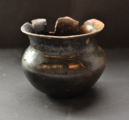VA·4.2
| Inscription | |
|---|---|
| Reading in transliteration: | viχu |
| Reading in original script: | |
| Variant reading: | ziχu |
|
| |
| Object: | VA·4 Sesto Calende (beaker) (Inscriptions: VA·4.1, VA·4.2) |
| Position: | neck, outside |
| Orientation: | 0° |
| Direction of writing: | dextroverse |
| Script: | unknown |
| Letter height: | 1.3–1.8 cm0.512 in <br />0.709 in <br /> |
| Number of letters: | 4 |
| Number of words: | 1 |
| Number of lines: | 1 |
| Workmanship: | scratched after firing |
| Condition: | damaged |
|
| |
| Archaeological culture: | Golasecca II A [from object] |
| Date of inscription: | early 6th c. BC [from object] |
|
| |
| Type: | unknown |
| Language: | unknown |
| Meaning: | unknown |
|
| |
| Alternative sigla: | Morandi 2004: 78 B |
|
| |
| Sources: | Morandi 2004: 572–574 no. 78 B |
Images
Commentary
First published in Binaghi & Rocca 1999: 443–447. Examined for LexLep on 26th January 2022.
Images in Binaghi & Rocca 1999: 443, fig. 4 (drawing), Sassatelli 2000: 54, fig. 34 (photo), Morandi 2001: 10 (drawing), Morandi 2004: 576, fig. 13.78 (drawing), Morandi 2004b: 82, fig. 4 (drawing) and 80 (photo), De Marinis 2009b: 425, fig. 13 (drawing = Maras 2014: 105, fig. 4b), Maras 2014: 79, fig. 2b (photo = Morandi 2017: 369, fig. 5), Morandi 2017: 375, fig. 7.3 (drawing).
Inscribed horizontally on the neck of the beaker (elngth 3.6 cm), at a distance of ca. 4 cm from VA·4.1. The sequence is only slightly damaged by abrasion. Rocca in the original publication suspects that the document is pseudo-script, arguing that the majority of characters cannot be clearly identified because they are merely imitations of letters. This is doubted by Sassatelli 2000: 55 f., who judges the dismissal of such a comparatively long document (parts 1 and 2 together) to be methodologically problematic, though he concedes that many letters appear to feature rather more lines than strictly necessary. Sassatelli supports the reading of the four-letter sequence as Etruscan ziχu 'scribe' (Sassatelli: 'scriptum', a possibility already mentioned by Rocca), suggesting that the vocabulary for the practice of writing may have been adopted from the language of those who introduced it. The Etruscan reading ziχu is also maintained by De Marinis 2009b: 425 and Maras 2014: 76 (no. 5), 2014b: 105.
The Celtic reading viχu goes back to Morandi 2001b: 62, n. 15, more elaborately in 2001: 10, where he proposes that the word is an on-stem personal name – that of the manufacturer or the person who deposited the object in the grave – comparing possibly Celtic viku in an Etruscan inscription from Clusium (also 2004: 573 f., 2004b: 82 f. and 2017: 369, attributing the superfluous scratches around the first letter to the scribe's "exuberance").
As observed by Dupraz 2015: 38, n. 16, viχu is the epigraphically preferable reading, insofar as there are five scratches around the letters, especially the first, which must be discounted in any case, and the apparent prolongation of the first letter's lower bar on the left may be classified as another of these superfluous lines. For a reading of the first letter as zeta, the upper bar, which does not even reach the hasta, must be assumed to have been drawn too short and then left in that easily remedied state. In fact, from a purely epigraphical standpoint, it is the short upper bar which looks like an unconnected scratch, so that tau ![]() cannot technically be excluded. It must be noted that, with its exess of lines, the inscription looks uncomfortably similar to VA·5, inscribed in the same spot on a similar beaker from the Golasecca necropolis, which is a comparatively script-like specimen of a group of clearly non-script marks on such beakers.
cannot technically be excluded. It must be noted that, with its exess of lines, the inscription looks uncomfortably similar to VA·5, inscribed in the same spot on a similar beaker from the Golasecca necropolis, which is a comparatively script-like specimen of a group of clearly non-script marks on such beakers.
Bibliography
| Binaghi & Rocca 1999 | Maria Adelaide Binaghi, Giovanna Rocca, "Sesto Calende (VA), loc. Presualdo", Studi Etruschi 63 (1997 [1999]), 437–447. |
|---|---|
| De Marinis 2009b | Raffaele C. de Marinis, "Presualdo, Rastrel Rosso e Brivio (Sesto Calende), tombe del Golasecca I e II", in: Raffaele C. de Marinis, Serena Massa, Maddalena Pizzo (eds), Alle origini di Varese e del suo territorio. Le collezioni del sistema archeologico provinciale [= Bibliotheca Archaeologica 44], Roma: L'Erma di Bretschneider 2009, 416–430. |
| Dupraz 2015 | Emmanuel Dupraz, "Nochmals zum lepontischen Digraphen uv-", Münchener Studien zur Sprachwissenschaft 69,1 (2015), 33–50. |


